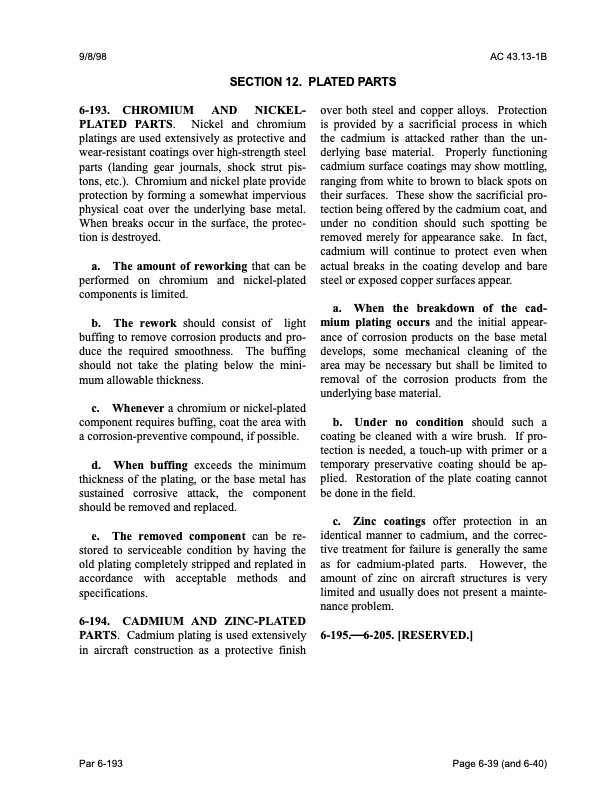
PDF Publication Title:
Text from PDF Page: 308
9/8/98 AC 43.13-1B 6-193. CHROMIUM AND NICKEL- PLATED PARTS. Nickel and chromium platings are used extensively as protective and wear-resistant coatings over high-strength steel parts (landing gear journals, shock strut pis tons, etc.). Chromium and nickel plate provide protection by forming a somewhat impervious physical coat over the underlying base metal. When breaks occur in the surface, the protec tion is destroyed. a. The amount of reworking that can be performed on chromium and nickel-plated components is limited. b. The rework should consist of light buffing to remove corrosion products and pro duce the required smoothness. The buffing should not take the plating below the mini mum allowable thickness. c. Whenever a chromium or nickel-plated component requires buffing, coat the area with a corrosion-preventive compound, if possible. d. When buffing exceeds the minimum thickness of the plating, or the base metal has sustained corrosive attack, the component should be removed and replaced. e. The removed component can be re stored to serviceable condition by having the old plating completely stripped and replated in accordance with acceptable methods and specifications. 6-194. CADMIUM AND ZINC-PLATED PARTS. Cadmium plating is used extensively in aircraft construction as a protective finish over both steel and copper alloys. Protection is provided by a sacrificial process in which the cadmium is attacked rather than the un derlying base material. Properly functioning cadmium surface coatings may show mottling, ranging from white to brown to black spots on their surfaces. These show the sacrificial pro tection being offered by the cadmium coat, and under no condition should such spotting be removed merely for appearance sake. In fact, cadmium will continue to protect even when actual breaks in the coating develop and bare steel or exposed copper surfaces appear. a. When the breakdown of the cad- mium plating occurs and the initial appear ance of corrosion products on the base metal develops, some mechanical cleaning of the area may be necessary but shall be limited to removal of the corrosion products from the underlying base material. b. Under no condition should such a coating be cleaned with a wire brush. If pro tection is needed, a touch-up with primer or a temporary preservative coating should be ap plied. Restoration of the plate coating cannot be done in the field. c. Zinc coatings offer protection in an identical manner to cadmium, and the correc tive treatment for failure is generally the same as for cadmium-plated parts. However, the amount of zinc on aircraft structures is very limited and usually does not present a mainte nance problem. 6-195.6-205. [RESERVED.] Par 6-193 Page 6-39 (and 6-40) SECTION 12. PLATED PARTSPDF Image | AFS-640

PDF Search Title:
AFS-640Original File Name Searched:
ac_43.13-1b_w-chg1.pdfDIY PDF Search: Google It | Yahoo | Bing
5,000 BF Shipping Container Lumber Dry Kiln For Quality Lumber The 5,000 BF container kiln consists of one 40 foot high-cube aluminum shipping container... More Info
Shipping Container Lumber Dry Kilns by Global Energy Global Energy designed and developed the container kiln back in 1991. The purpose is to give access to portable sawmill owners, furniture makers, and small business the value added profit of dry kiln lumber and quality hardwoods... More Info
Vacuum Kiln Conversion Kit for Lumber and Wood Dry Kilns Convert your existing conventional dry kiln into a fast drying vacuum kiln. Similar to vacuum bagging in the boat building and aircraft industry, we have come up with a proprietary process which allows you to build a very simple vacuum kiln at a fraction of the price, and without the intensive conventional metal chamber structure... More Info
Vacuum Pump Cart System for Bagging Clamping Wood Drying and more Vacuum Cart with 2HP Pump and Dual Pistons with multiple multiplex vacuum ports and liquid reservoir... More Info
Vacuum Bagging Basics Vacuum bagging is a method of clamping, which has traditionally been used in the composites industry, but can also be used for vacuum drying materials, including wood products... More Info
| CONTACT TEL: 608-238-6001 Email: greg@globalmicroturbine.com | RSS | AMP |